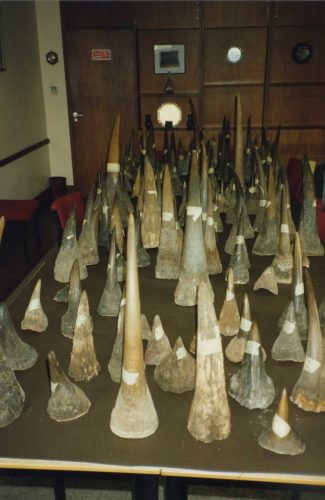Keepers are celebrating the birth of a rare baby rhino!
The female calf was safely delivered by new mum Ema Elsa following a 15-month-long pregnancy.
The birth was caught on the zoo’s CCTV cameras and shows the little one up on her feet and suckling from mum just 10 minutes later.
Conservationists at the zoo say the arrival of the calf – an eastern black rhino – will be ‘celebrated globally’ as fewer than 1,000 now remain on the planet.
The population of eastern black rhinos in zoos across Europe is vital to the long-term future of the species, with several rhinos born as a result of the carefully coordinated breeding programme between European zoos having been introduced to Africa to boost wild populations.
Most recently, in June 2019, experts at the zoo spearheaded the transportation of a group of eastern black rhinos from Europe to Akagera National Park, Rwanda.
PSSSTT
“The birth of a critically endangered eastern black rhino is always very special. And to be able to watch on camera as a calf is born is an incredible privilege – with rhino numbers so, so low it, sadly, isn’t something that’s captured very often. Seeing the little one then get to her feet with a gentle nudge from mum; take her first tentative steps and suckle for the first time is then the icing on the cake. It really is heart-warming stuff.”
Andrew McKenzie, Team Manager of rhinos at the zoo
“The whole team here is overjoyed. Mum and calf have bonded wonderfully and have been showing us all of the right signs. These rhinos have been pushed to the very edge of existence and every single addition to the European endangered species breeding programme is celebrated globally. It’s sadly no exaggeration to say that it’s entirely possible that we could lose them forever within our lifetime and the world’s most progressive zoos are very much part of the fight to prevent their extinction.”
The eastern black rhino is listed by the International Union for the Conservation of Nature (IUCN) as critically endangered. In the wild, they are now found only in Kenya, Tanzania and Rwanda.
Experts say the multibillion pound illegal wildlife trade is driving the species towards extinction – the surge in demand of rhino horn stemming from the Asian medicine market.

Andrew added:
“In the short term, Ema Elsa and her new baby will help to highlight the perilous position that this species is in and we hope they encourage more people to join the fight to prevent the extinction of these gentle giants. In the future, as we work to ensure more safe areas, we hope Ema and her offspring, like others before them born into the European breeding programme, are one day able to make the journey back to Africa.”
Conservation scientists here at the zoo, working out of the UK’s only zoo-based animal endocrine lab, have developed a technique to track black rhino oestrus cycles via hormone analysis of their dung – helping keepers to decide when best to introduce females to a mate to help optimise chances of a successful mating outcome, and subsequently confirm and track a pregnancy. This method is now being used in Kenya where rangers and vets, using a field lab set up with the help of experts from Chester, are deploying the technique to monitor wild rhino populations.
![]() In addition to rhino breeding, we have, for many years, also supported conservation efforts to protect eastern black rhinos in Africa and continue to fund and provide expertise to numerous sanctuaries, partners and wildlife reserves and to train anti-poaching rangers.
In addition to rhino breeding, we have, for many years, also supported conservation efforts to protect eastern black rhinos in Africa and continue to fund and provide expertise to numerous sanctuaries, partners and wildlife reserves and to train anti-poaching rangers.
Protecting the last Rhino’s
The illegal wildlife trade is ruthless in its pursuit of rhino species, pushing them to the brink of extinction. Often killed for their ivory horns and use in asian medicines, there are now less than 1,000 eastern black rhino’s left on the planet. We must act for wildlife NOW, to prevent extinction.
What we do
We’ve been working in the field and with partners to protect the remaining eastern black rhino populations of the world. Find out more about our field work, scientific research, conservation efforts and our relentless pursuit to prevent their extinction.
Celebrate with Chester Zoo
Commemorate the birth of our rare eastern black rhino with your very own print. As one of the first photograph’s taken of our new baby rhino calf, this is an amazing way of sharing a special moment with us.